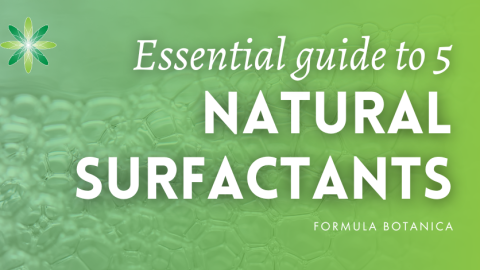The indie beauty market is growing in response to consumers’ desire to use sustainable botanical ingredients in their daily skincare products. Sustainability in the skincare industry is of paramount importance to consumers these days as issues such as ocean plastics, zero waste, fair trade and bio-based packaging have taken centre stage.
Natural organic skincare brands can’t live off brand promise alone. They need to demonstrate pukka credentials and be transparent throughout their supply and production chains if they are to gather a loyal tribe of customers. In these days of social media, consumers can fall out of love with a brand in an instant if they discover a false claim or if a brand is less than transparent about how it does business. Our interview with green beauty blogger Sarita Cohen highlights just some of the penetrating questions consumers ask natural beauty brands.
The pressure is on then for green beauty entrepreneurs to understand their supply chains thoroughly. However, there’s help at hand. In this post we give you some practical advice on how to source sustainable botanical ingredients for your skincare formulations.
Get To Know Your Suppliers
If you are like me, you are constantly striving to maintain your promise to provide your customers with truly “green” beauty. There are several steps you can take to ensure that your products do not harm the earth and sourcing sustainable botanical ingredients with care is one of the most important ones. It is possible to buy responsibly-produced, raw materials and by doing so you can even contribute to conservation efforts.
Every time you purchase raw materials for your formulations, you help botanical ingredient producers continue their work. But it is important for you to get to know them and understand where and how they make your precious oils, extracts and hydrosols.
Armed with this knowledge, you can be confident that you are investing in businesses which care about the environment and the people they may employ. The growth of the natural beauty market is not only a chance for us to create amazing products but also for us to make a difference to the planet by encouraging new, more ethical and nature-friendly industry practices.
Who Harvests your Botanical Ingredients?
Knowing where our ingredients come from is important for the long-term sustainability of nature and also the livelihoods of the people working to harvest and produce them. The local communities who harvest the plants for your ingredients are the most important link in the supply chain.
When collectors work under fair conditions they are likely to do their job conscientiously, contributing to the quality and sustainability of our products. When harvesting medicinal plants, strict rules about the quantity and method of collection must be followed to maintain good quality and preserve nature. This can only happen if workers are trained and motivated.
7 tips on sourcing sustainable botanical ingredients for your skincare formulations. Consumers demand #greenbeauty transparency! #ecobeauty #formulabotanica Share on XIn Bulgaria, one of the world’s biggest herb exporters, the most successful examples of fair and sustainable practices we have seen are those of producers who hire the same workers every year. They tend to care for the welfare of their employees and make efforts to provide social benefits to them and their children. This has a knock-on effect on the quality of the products they offer and gives them and the buyers of their products a market advantage.
An inspiring example comes from one such producer who works in a small village in Bulgaria’s Rose Valley. We chose to buy from him, because he always welcomes us to his extraction facility and is completely transparent about who he works with and how he operates his business. This speaks volumes about his ethos!
7 Tips for Sourcing Sustainable Botanical Ingredients
As consumers become ever more educated and demanding, so must we. To preserve our beautiful planet and give clients the best possible skincare, you should always strive to:
1. Source locally
Buy from suppliers you know – ideally local to you – who treat their workers and the environment with respect. By doing so, you are not just guaranteed the freshest ingredients, but you are supporting also local communities and the very people who come into daily contact with nature, and feel engaged and empowered to protect it. By receiving a fair wage and enjoying good working conditions, they grow to appreciate nature and the benefits it brings them. These types of suppliers will enable you to source sustainable botanical ingredients with peace of mind.
If you cannot buy direct from local suppliers, ask where the plant material used to produce the extracts comes from. Often, you will discover that even raw materials are traded many times before reaching the extraction facility.
2. Research Exotic Ingredients
When it comes to ingredients considered more “exotic” and not local to your area, strive to buy them directly from their country of origin from suppliers who can certify that they adhere to strict environmental and ethical principles. Research them online and by accessing local databases, cooperatives and other industry or marketing bodies and by going to international fairs. Do not underestimate the power of personal contact. Many small producers relish the opportunity to get in touch with their clients first hand.
3. Research Resellers and Retailers
If you cannot source directly from producers make sure that the shops you buy from can give you complete information about the origin of the ingredients they offer. Many suppliers and resellers will be happy to do so and supporting them is worth it. Ask them:
- Where does the ingredient come from?
- Who produced it?
- Where and by whom was the plant material collected?
- Were the plants wild harvested or cultivated?
4. Look for Fair Trade & Other Accreditation
This might seem obvious, but we often tend to forget to look for suppliers who can demonstrate bona fide accreditation from recognised bodies such as Fair Trade and other sustainability schemes. You can then cross reference their claims on the accreditation bodies’ sites.
5. Bulk Purchase
Get together with other formulators and brand owners in your area and bulk order exotic ingredients directly from suppliers. This can help to reduce costs.
6. Keep Updated Records
Create your own Excel database for each of the ingredients you use. Include the contact information of suppliers you have identified, the origin of the ingredients they offer, the minimum order quantities (MOQs), prices, shipping costs, certificates and all other relevant information. In this way you can easily prioritise each supplier and calculate exactly how much more it will cost you to apply sustainability standards to your purchasing. You might be surprised to find that the “premium” is not that high.
7. Educate your Customers
Communicate the importance of ethical ingredient sourcing. Spread awareness among your consumers by sharing your experiences and give them concrete, easy-to-remember examples. This will motivate them to choose your brand and make other responsible purchasing choices. In the words of sustainability advocate Anna Lappé, remember: “Every time you spend money you’re casting a vote for the kind of world you want”.
Each of our voices and choices can contribute towards a healthier, brighter future for our planet. Your customers depend on you to uphold your promise of sustainability and quality. Luckily for us, the two go hand in hand.
Useful Links
Global Shea Alliance
Cocoa Alliance
Rainforest Alliance
Sustainable Herbal Harvest in Bulgaria
Our Guest Contributor
We would like to thank Anna Galabova for kindly contributing this post. Anna is owner of Wild Cosmetics – a skincare brand that brings the sensation of wild nature into daily beauty rituals. She is passionate about environmentally-friendly medicinal plant harvesting and hopes to educate about the topic through her work.
Leave us a comment

Gemma Ortega Perez was Formula Botanica’s Relationship Manager between 2015 – 2019. To read more about the Formula Botanica team, visit our staff page.



























